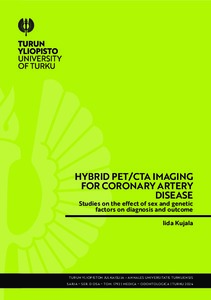Hybrid PET/CTA imaging for coronary artery disease: Studies on the effect of sex and genetic factors on diagnosis and outcome
Kujala, Iida (2024-05-25)
Hybrid PET/CTA imaging for coronary artery disease: Studies on the effect of sex and genetic factors on diagnosis and outcome
Kujala, Iida
(25.05.2024)
Turun yliopisto
Julkaisun pysyvä osoite on:
https://urn.fi/URN:ISBN:978-951-29-9699-5
https://urn.fi/URN:ISBN:978-951-29-9699-5
Tiivistelmä
ABSTRACT
Coronary computed tomography angiography (CTA) enables non-invasive detection of coronary atherosclerosis and obstructive coronary artery disease (CAD). In turn, positron emission tomography angiography (PET) myocardial perfusion imaging (MPI) enables detection of hemodynamically significant coronary artery stenoses and myocardial ischemia. In hybrid imaging, data from coronary CTA and PET MPI are combined providing complementary information about coronary anatomy and physiology.
We have comprised an observational retrospective registry of patients who have been imaged in Turku PET Centre with a hybrid imaging protocol due suspected obstructive CAD.
We evaluated sex differences in disease profile and outcomes after hybrid imaging. We found that women have lower prevalence of ischemic CAD and lower rate of adverse events (unstable angina pectoris, myocardial infarction, death). Importantly, hybrid imaging predicted outcomes equally in women and men. We also investigated the incremental value of PET imaging over CTA in predicting short- and long-term outcomes. PET MPI improved the prediction of adverse events beyond CTA imaging for the first 4 years of follow-up. After this period MPI did not add prognostic power over CTA. This illustrates the complementary nature of anatomic and functional imaging in the prediction of outcome in patients with suspected CAD.
Above this, we collected blood samples from the registry patients and assessed the predictive power of the 3 most promising polygenic risk scores (PRS) in prediction of coronary atherosclerosis and obstructive CAD. We found that the addition of PRS to classical clinical risk factors did not clinically significantly improve the predictive accuracy for either coronary atherosclerosis or obstructive CAD, indicating that current PRSs are not justified for clinical routine for CAD.
KEYWORDS: coronary artery disease, hybrid imaging, polygenic risk score, prognosis TIIVISTELMÄ
Sepelvaltimoiden tietokonetomografia tutkimus (CTA) on kajoamaton ja tarkka kuvantamismenetelmä, jonka avulla voidaan luotettavasti poissulkea ahtauttava sepelvaltimotauti. CTA kuvantamisessa todettu ahtauma ei kuitenkaan aina ole hemodynaamisesti merkittävä. Positroniemissiontomografia (PET) mahdollistaa hemodynaamisesti merkittävien ahtaumien ja sydänlihasiskemian arvioimisen. Hybridikuvantamisessa yhdistämme nämä kaksi kuvantamismenetelmää saadaksemme tietoa sekä potilaan sepelvaltimoiden anatomiasta että tautimuutosten merkityksestä.
Olemme koostaneet havainnoivan retrospektiivisen rekisterin Turun PET-keskuksessa tutkituista potilaista, joilla on epäilty oireiden aiheuttajana ahtauttavaa sepelvaltimotautia.
Me tutkimme eroavaisuuksia hybridikuvantamisen ennustearvossa miesten ja naisten välillä, sekä eroavaisuuksia sepelvaltimotaudin luonteessa. Havaitsimme, että naisilla esiintyy miehiä harvemmin sydänlihaksen iskemiaa aiheuttavaa sepelvaltimotautia. Naisilla havaitsimme esiintyvän myös vähemmän päätetapahtumia (epästabiili angiina, sydäninfarkti, kuolema). Hybridi kuvantamisen tulokset ennustivat päätetapahtumia naisilla ja miehillä yhtäläisesti. Tutkimme myös PET kuvauksen tuomaa lisähyötyä ennustearvossa CTA kuvantamisen jälkeen. PET kuvantaminen toi lisäarvoa päätetapahtumien ennustamisessa ensimmäisen 4 vuoden seuranta-ajan aikana. Tämän jälkeen ennustearvossa ei havaittu eroa.
Tämän lisäksi keräsimme osalta potilaista verinäytteitä ja selvitimme geneettisten riskipisteytyksien tarkkuutta sepelvaltimotaudin todennäköisyyden arvioinnissa oireisilla potilailla. Totesimme, että geneettiset riskipisteytykset eivät tuoneet kliinisesti merkittävää lisäarvoa kliinisiin riskitekijöihin lisättynä. Tämän perusteella geneettisten riskipisteytysten käyttö ei ole perusteltua kliinisessä työssä sepelvaltimotaudin todennäköisyyttä arvioitaessa.
AVAINSANAT: sepelvaltimotauti, hybrikuvantaminen, geneettinen riskipisteytys, ennustearvo
Coronary computed tomography angiography (CTA) enables non-invasive detection of coronary atherosclerosis and obstructive coronary artery disease (CAD). In turn, positron emission tomography angiography (PET) myocardial perfusion imaging (MPI) enables detection of hemodynamically significant coronary artery stenoses and myocardial ischemia. In hybrid imaging, data from coronary CTA and PET MPI are combined providing complementary information about coronary anatomy and physiology.
We have comprised an observational retrospective registry of patients who have been imaged in Turku PET Centre with a hybrid imaging protocol due suspected obstructive CAD.
We evaluated sex differences in disease profile and outcomes after hybrid imaging. We found that women have lower prevalence of ischemic CAD and lower rate of adverse events (unstable angina pectoris, myocardial infarction, death). Importantly, hybrid imaging predicted outcomes equally in women and men. We also investigated the incremental value of PET imaging over CTA in predicting short- and long-term outcomes. PET MPI improved the prediction of adverse events beyond CTA imaging for the first 4 years of follow-up. After this period MPI did not add prognostic power over CTA. This illustrates the complementary nature of anatomic and functional imaging in the prediction of outcome in patients with suspected CAD.
Above this, we collected blood samples from the registry patients and assessed the predictive power of the 3 most promising polygenic risk scores (PRS) in prediction of coronary atherosclerosis and obstructive CAD. We found that the addition of PRS to classical clinical risk factors did not clinically significantly improve the predictive accuracy for either coronary atherosclerosis or obstructive CAD, indicating that current PRSs are not justified for clinical routine for CAD.
KEYWORDS: coronary artery disease, hybrid imaging, polygenic risk score, prognosis
Sepelvaltimoiden tietokonetomografia tutkimus (CTA) on kajoamaton ja tarkka kuvantamismenetelmä, jonka avulla voidaan luotettavasti poissulkea ahtauttava sepelvaltimotauti. CTA kuvantamisessa todettu ahtauma ei kuitenkaan aina ole hemodynaamisesti merkittävä. Positroniemissiontomografia (PET) mahdollistaa hemodynaamisesti merkittävien ahtaumien ja sydänlihasiskemian arvioimisen. Hybridikuvantamisessa yhdistämme nämä kaksi kuvantamismenetelmää saadaksemme tietoa sekä potilaan sepelvaltimoiden anatomiasta että tautimuutosten merkityksestä.
Olemme koostaneet havainnoivan retrospektiivisen rekisterin Turun PET-keskuksessa tutkituista potilaista, joilla on epäilty oireiden aiheuttajana ahtauttavaa sepelvaltimotautia.
Me tutkimme eroavaisuuksia hybridikuvantamisen ennustearvossa miesten ja naisten välillä, sekä eroavaisuuksia sepelvaltimotaudin luonteessa. Havaitsimme, että naisilla esiintyy miehiä harvemmin sydänlihaksen iskemiaa aiheuttavaa sepelvaltimotautia. Naisilla havaitsimme esiintyvän myös vähemmän päätetapahtumia (epästabiili angiina, sydäninfarkti, kuolema). Hybridi kuvantamisen tulokset ennustivat päätetapahtumia naisilla ja miehillä yhtäläisesti. Tutkimme myös PET kuvauksen tuomaa lisähyötyä ennustearvossa CTA kuvantamisen jälkeen. PET kuvantaminen toi lisäarvoa päätetapahtumien ennustamisessa ensimmäisen 4 vuoden seuranta-ajan aikana. Tämän jälkeen ennustearvossa ei havaittu eroa.
Tämän lisäksi keräsimme osalta potilaista verinäytteitä ja selvitimme geneettisten riskipisteytyksien tarkkuutta sepelvaltimotaudin todennäköisyyden arvioinnissa oireisilla potilailla. Totesimme, että geneettiset riskipisteytykset eivät tuoneet kliinisesti merkittävää lisäarvoa kliinisiin riskitekijöihin lisättynä. Tämän perusteella geneettisten riskipisteytysten käyttö ei ole perusteltua kliinisessä työssä sepelvaltimotaudin todennäköisyyttä arvioitaessa.
AVAINSANAT: sepelvaltimotauti, hybrikuvantaminen, geneettinen riskipisteytys, ennustearvo
Kokoelmat
- Väitöskirjat [2885]
